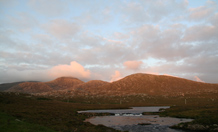Blanket bogs, which provide vital habitats for a unique range of plants, birds, small mammals, reptiles and amphibians, are at risk of declining as a result of climate change.
Research by the Universities of Exeter and Bristol in the UK and Macquarie University in Australia, published in the journal Nature Climate Change, shows for the first time how rising temperatures will threaten these sensitive ecosystems.
The study highlights the urgency of developing a plan to protect these important habitats.
Found in wet, coastal areas of high latitude regions, blanket bogs cover around 700,000 hectares of land in the UK, much of it designated as a Site of Special Scientific Interest (SSSI). Blanket bogs are found in the north and west of the UK, extending from Devon in the south to Shetland in the north, and it has been estimated that 10 to15 per cent of the world’s blanket bog occurs in Britain. As well as being crucial in supporting wildlife, blanket bogs also capture and store large amounts of carbon, helping to mitigate against climate change, and reduce the risk of flooding, by slowing down water flow. With some blanket peat being over 9,000 years old, they also hold historically-significant archaeological material.
Blanket bogs are sensitive to changes in climate as they depend on a permanently high water table and suffer in temperatures above 15 degree Celsius. Scientists have been concerned about the future for blanket bogs, but have not previously been able to accurately predict how these habitats will change as a result of projected future temperatures – until now. This research shows that rising temperatures will cause blanket bogs to be exposed to a climate that will no longer support active growth of the peat mass or support the same vegetation as it does now.
The research team developed a new model to predict how the area now covered in blanket bogs will change, under a range of different climate conditions. They found that if climate change occurs at predicted levels, blanket bogs will be outside their climatic limits more and therefore more vulnerable to erosion and unlikely to be actively growing. They also discovered that there is a possibility that blanket bogs could appear further north, as a result of increased rainfall in parts of Norway, Russia, Canada and Alaska. However, it is not clear how well blanket bogs could establish themselves in these new locations or what wildlife they might support.
Lead researcher Dr Angela Gallego-Sala of Geography at the University of Exeter said: “Although scientists and ecologists have been concerned about the future of these habitats, no-one has managed to map out the likely impact of climate change on blanket bogs until now. Our study has revealed how vulnerable they are. It is now crucial for a plan to be put in place to protect these unique ecosystems and the wildlife they support.”
Harriet Orr of the Environment Agency added: “Blanket bogs are part of the rich tapestry of the British countryside and provide vital life support services for people and wildlife. This new research shows that climate change could have a devastating impact on blanket bogs and reinforces the case for taking action to limit climate change by cutting greenhouse gas emissions and to protect these important habitats.”
This research was supported by the Environment Agency and Natural Environment Research Council (NERC).
*Source: University of Exeter

